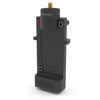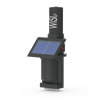WiSI™ Ordering
When determining which WiSI configuration is right to use in your wireless network, please take into consideration the following details that must be determined.
Available Configurations
| The I/O configuration is set in hardware; all WiSI (unless noted otherwise) come with 4 digital inputs, 4 digital outputs and 4 analog inputs. |
| Analog Input Channel Types |
- 0 - 5 volts or 0 - 2.5 volts
- 0 - 32 volts
- 0 - 20 mA
- ±1.8 volts
-
0 - 2.2 volt
|
| If the analog input combination you desire is not listed below, please contact Rugid as the combination of analog channels is changeable: |
| Configuration |
I/O Channels |
Node Types |
Package Types |
Antenna |
| A |
AI Channels
•0 - 5 volts or 0 - 2.5 volts
•0 - 5 volts or 0 - 2.5 volts
•0 - 2.2 volt
•0 - 20 mA
DI Channels
•4 DI
•4 DO |
Coordinator, Router, End |
EP, SP |
EA, SMA |
| B6 |
AI Channels
•0 - 5 volts or 0 - 2.5 volts
•0 - 5 volts or 0 - 2.5 volts
•0 - 5 volts or 0 - 2.5 volts
•0 - 5 volts or 0 - 2.5 volts
DI Channels
•4 DI
•4 DO
Loop Supply
•6 volts
|
End |
SP |
EA, SMA |
| C |
AI Channels
•0 - 20 mA
•0 - 20 mA
•0 - 20 mA
•0 - 20 mA
DI Channels
•4 DI
•4 DO |
Coordinator, Router |
EP |
EA, SMA |
| D |
AI Channels
•0 - 5 volts or 0 - 2.5 volts
•0 - 32 V
•0 - 20 mA
•0 - 20 mA
DI Channels
•4 DI
•4 DO |
Coordinator, Router |
EP |
EA, SMA |
| N |
NO I/O |
Coordinator, Router |
EP |
EA, SMA |
Node Type
| The node type ships from the factory configured as one of the following: |
| Coordinator |
- An essential node to every system, please note that every system must have 1 Coordinator (thus a system will consist of AT LEAST 2 nodes).
- Provides message routing, security management and acts as a Modbus slave to an upstream RTU passing data to and from the WiSI network.
- May also gather local data and respond to digital I/O requests the same as Routers and End-nodes.
- Remains active and therefore cannot sleep.
|
| Router |
- Relays messages from one node to another (routing).
- Allows other nodes to connect to it.
- Gathers local data and responds to digital I/O requests.
- Remains active and therefore cannot sleep.
|
| End |
- Communicates with upstream Routers or the System Coordinator.
- Can be externally powered, or self powered with its own integrated solar power source and long life super capacitor storage.
- Cannot relay messages and cannot allow other nodes to connect to the network through them.
- Gathers local data and responds to digital I/O requests.
- Sleeps when not gathering, transmitting or receiving data.
|
Package Type
| EP |
- Powered externally from 6-24 volts DC.
- Coordinator, Routers, & End-nodes.
- Easily mounts inside a 2-inch ID pipe or backpan.
|
|
| SP |
- Powered from local solar panel and maintenance-free engergy storage or external 6-12 volts DC.
- End-nodes only.
- Easily mounts inside a 2-inch ID pipe.
|
|
Antenna
| EA |
- Embedded 2.5 db gain omni antenna.
|
| SMA |
- Reverse polarity SMA connector.
|
For a downloadable .pdf of WiSI pricing click
here
Rugid products are proudly designed and manufactured in the USA.
All offerings reflect the most current product revision.
Rugid is frequently improving the products and reserves the right to improve the product without notifying the customer.
Terms and Conditions Privacy Policy
©2000-2023 Rugid - An Outside The Box Engineering, LLC Brand - All rights reserved.




